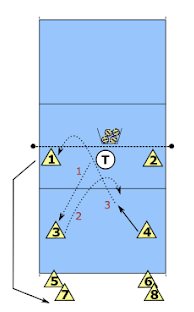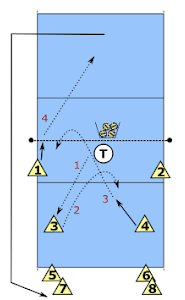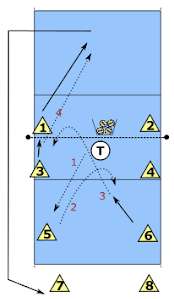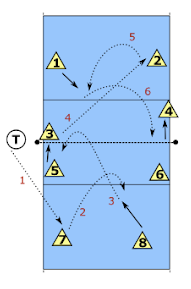Volleyball drills
This exercise starts reasonably simple and is then gradually expanded (can be done in 1 training session or spread over several sessions). An exercise in which everyone must defend, set and attack.
It is a long piece of text, but it is easier than the length of the text suggests. Just do it!
Requirements:
It is a long piece of text, but it is easier than the length of the text suggests. Just do it!
Requirements:
- at least 2 ballsminimum
- 8 players (preferably an even number)
Part 1

It starts with two players at the net (1 and 2), two players in the backfield (3 and 4) and the rest behind the backline. The trainer stands at the net in the middle position with two balls.
Once the players know the patterns, this exercise can be done at a fast pace.
- The trainer throws or hits the ball towards player 3 (1 ). Player
- 3 passes the ball to the middle of the field about on the 3 meter line (2).
- Player 4 runs in and gives a setup to the left front (3 ).
- Player 1 catches the ball, throws the ball in the ballcarrier and runs to the backline and connects with the back.
- The trainer throws or punches the ball towards player 4. Player
- 4 passes the ball to the middle of the field about on the 3 meter line.
- Player 3 runs in and gives a setup to the right front.
- Player 2 catches the ball, throws the ball in the ballcarrier and runs to the backline and connects with the back.
- Player 3 goes to the left front and player 4 turns to the right front.
Once the players know the patterns, this exercise can be done at a fast pace.
Part 2

- The trainer throws or hits the ball towards player 3 (1 ). This is the moment that players 1 and 2 run backwards to make an attack.
- Player 3 passes the ball to the middle of the field about on the 3 meter line (2 ).
- Player 4 runs in and gives a setup to the left front (3 ).
- Player 1 smashes the ball over the net (4
- The trainer throws or hits the ball towards player 4. Player
- 4 passes the ball to the middle of the field about on the 3 meter line.
- Player 3 runs in and gives a setup to the right front.
- Player 2 smashes the ball over the net, picks it up and puts it in the ballcarrier of the trainer. Then player 2 runs to the backline and joins the backline.
- Player 3 goes to the left front and player 4 turns to the right front.
Part 3

The exercise now starts with 6 players in the field. There are now two more blockers, who stand at the other side of the net.
- The trainer throws or hits the ball towards player 5 (1 ). This is the moment that players 3 and 4 run backwards to make an attack.
- Player 5 passes the ball to the middle of the field about on the 3 meter line (2 ).
- Player 6 runs in and gives a setup to the left front (3 ).
- Player 3 smashes the ball over the net (4 ).
- Player 1 tries to block the smash.
- The trainer throws or hits the ball towards player 6. Player
- 6 passes the ball to the middle of the field about on the 3 meter line.
- Player 5 runs in and gives a setup to the right front.
- Player 4 smashes the ball over the net. Player
- 2 tries to block the smash.
- Player 5 moves to the left front and player 6 turns to the right front.
- Player 3 and 4 move to the blocking positions.
- Player 1 and 2 get the ball in the ballcar and go to the backline.
Part 4

There are now 8 players in the field. The trainer only throws the first ball, then the game continues.
The same patterns as in the previous sections are executed: the players in the backfield take care of the pass and the setup. The players at the net smashem and block.
If there are more than 8 players, the game continues after, say, 10 attacks or so.
The same patterns as in the previous sections are executed: the players in the backfield take care of the pass and the setup. The players at the net smashem and block.
If there are more than 8 players, the game continues after, say, 10 attacks or so.
Goal of the exercise:
Ball carrier must learn to act quickly after set-up and find new ball
Explanation of the exercise:
- Playmaker exercise.
- Five on one side of the net.
- On the other side, you could also have 5.
- Front left and front right both have a ball.
- Playmaker stands in the middle.
- The left back and right back bring the pass.
- The first ball is thrown by the left back towards the left back.
- At the moment the left back touches the ball, the right back throws the ball to the right back.
- If you have more players, you can choose to change the one who passed with the one who is on hold.
- In this way, the passes reach the defender immediately after each other.
- The pass from the left back is played by the distributor to the left front.
- Immediately after the set-up, do not follow the ball but look for the other pass from the right back and set-up the set-up for the right front.
- Many ball contacts for the playmaker.
Practise top hand service.
Build up in steps
- Throwing up ->
- Throw up the ball with 1 or 2 hands.
- Straight up, slightly in front of the body.
- After throwing up, point to the ball with the non-striking arm.
- Drop the ball to the ground, it should land on the service line.
- Catch ->
- The ball is thrown up and caught between the pointing arm and the striking hand.
- Both arms are extended
- Striking ->
- The ball is thrown up and hit.
- Make sure to finish the striking movement (strike through the ball).
- 5 players per field
- 1x setter,
- 2 attackers, left and right,
- 2 defenders, left and right
- Set to LV
- Set ball to RA
- Pass to SV
- Set to RV
- Set ball to LA
- Pass to SV
- If the game is running, it can be beaten (quietly).
- With >5 players per side, pass in turns.
- After 5 balls each attacker must turn 1 place.
Circuit of strength exercises 2-4 x 20 sec work.
- Jumping jacks
- Bench Dips
- Sit-ups
- Climbing on bench
- Wall-sit
- One of the two players stands at the net, the other in the backfield. The players play over BH, with an in-between ball.
- After the signal of the coach the ball must be played to the other side. The ball must be turned in during the interim test.
- After the signal of the trainer the ball must be turned half a turn during the in-between try.
- After the signal of the trainer the first ball must be received underhand, the ball to the other must remain above hand.
- One player stands on the left front side and comes walking up to the middle (after a hit on the ball from the trainer) and gives a set up for or behind the back (trainer indicates).
- Trainer throws the ball to the trainer or one of the players at the front of the court.
- Set up a basket on the right and left side in front of the court where the ball has to be played into.
- After the set up, fetch the ball.
Trainers throw ball to over the net and player:
- Throw ball into field let it bounce and step over it.
- Catch oh the ball
- Catches bra the ball
- Catches the ball sitting down
- Catches the ball with 1 knee on the ground
- Lies down on the ground and drops the ball on the buttocks
https://www.youtube.com/watch?v=nA-aXXA5ex8
- 1 ball per pair,
- replay in a pair
- Interrupt:
- Technique explanation,
- variation: only overhand/only underhand.
- Two persons one ball and one tennisball.
- One plays the ball overhand and the other throws the tennis ball to the other.
- This can also be done underhand.
- Attack with block and striker goes to cover immediately.
- The trainer blocks together with a player
- After the block, try to defend the ball
- After defending, take the ball and play in line.







